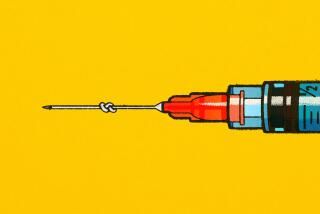Teens on Pins and Nails When It Comes to Body Art
- Share via
MINNEAPOLIS — Erik Hansen rolls up his left sleeve to reveal a roughly drawn skull-and-crossbones tattoo. A friend did it for him a few weeks ago, using a needle and ink at what Hansen calls a “poke and stick party” -- a growing trend among young people as tattoos and piercings have surged in popularity.
Body art between friends can be a rite of passage, a backroom ritual often done on the sly.
Teenagers talk about school athletes doing tattoos or piercings for one another as an initiation.
“It’s more fun to have a friend do it -- and it was free,” said Hansen, 20, of Minneapolis.
But officials where he lives -- and in other places nationwide -- are worried. In Hennepin County, which includes Minneapolis, they’ve started a poster campaign in schools and neighborhood hangouts to encourage young people to have tattoos and piercings done by licensed professionals.
“Get the good design, not a bad disease!” says one poster about tattooing. Another features a photo of an upper-lip piercing with warnings about the risk of infections, blood-borne diseases and nerve damage.
The Oregon Health Licensing Office has a similar Web-based campaign, begun after several young people from the town of Klamath Falls got serious upper ear infections from piercings done at a jewelry kiosk with lax sterilization procedures. The cases -- and resulting disfiguration -- were documented in a recent issue of the Journal of the American Medical Assn.
Meanwhile, the Texas Department of Health library offers a video for teens and young adults titled “Tattooing and Body Piercing: Thinking Smart About Body Art.” And Connecticut is among states with a brochure that has similar information.
The biggest concerns include the potential spread of tetanus and hepatitis B or C if people share tattooing needles or whatever sharp objects -- pins and nails included -- that are used to do their piercing.
“It’s just not something you can do in your garage,” said Shahn Anderson, a licensed tattooist and president of the Alliance of Professional Tattooists, who helped design the Hennepin County campaign.
Katie Klaren, 18, thinks that posting the information is a good idea.
“Anything but ears, I would want a professional to do,” the high school senior from Roseville, Minn., said as she waited at a licensed piercing studio in Minneapolis with her friend, Leslie Barker. The fresh-faced teens were there to have their nipples pierced -- a procedure that has become trendy since Janet Jackson’s Super Bowl flash.
“It’s an on-the-edge kind of thing,” Barker said, adding that both waited until they turned 18 so they wouldn’t need written parental permission -- required in Hennepin County since last summer.
Several states, including California, have laws that prohibit minors from getting tattoos or “body art” regardless of who’s holding the needle. And others, such as Wyoming, are considering bans.
Often, licensed piercers and tattooists have even stricter standards than states or cities, requiring a parent to be present or, in some cases, setting their own age limits for certain procedures.
Some youths think that banning them from having work done, or requiring parental permission, is only causing more minors to do the piercing themselves or seek out unlicensed amateurs, known in the industry as “scratchers.”
“You can’t just outlaw things,” said Hansen, who says he could not have afforded a professional tattoo even if he’d wanted one. “It’s like prohibition; it doesn’t work.”
Gail Dorfman -- the Hennepin County commissioner whose age-limits ordinance prompted the safety campaign -- disagrees.
“We’re not telling kids they shouldn’t get tattoos or piercings,” said Dorfman, who’s also the mother of five teenagers. “We’re just saying, ‘Be smart about it.’ ”
She says doctors and nurses at the county’s hospital have seen a spike in young people with infections caused by amateur work, sometimes done by friends or unlicensed operators. She also notes the case of a 19-year-old woman who pleaded guilty to a misdemeanor for doing piercings in a vehicle near a Minneapolis high school and another in suburban Wayzata last year.
Jesika Bornsen, a professional piercer at a shop called Saint Sabrina’s in Minneapolis, agrees that the campaign can only help educate teens and parents.
“It’s saying, ‘Talk to your parents about it,’ ” said Bornsen, a member of the Assn. of Professional Piercers who has worked in the field for eight years.
She says parents also might be pleasantly surprised if they checked out licensed piercing and tattoo facilities, which increasingly look more like spas than darkened back rooms.
In the end, she said, “Parents have to pick their battles.”
“Do you want your kid to have a healthy piercing?” she asked. “Or the safety pin in their eyebrow?”
More to Read
Sign up for Essential California
The most important California stories and recommendations in your inbox every morning.
You may occasionally receive promotional content from the Los Angeles Times.










